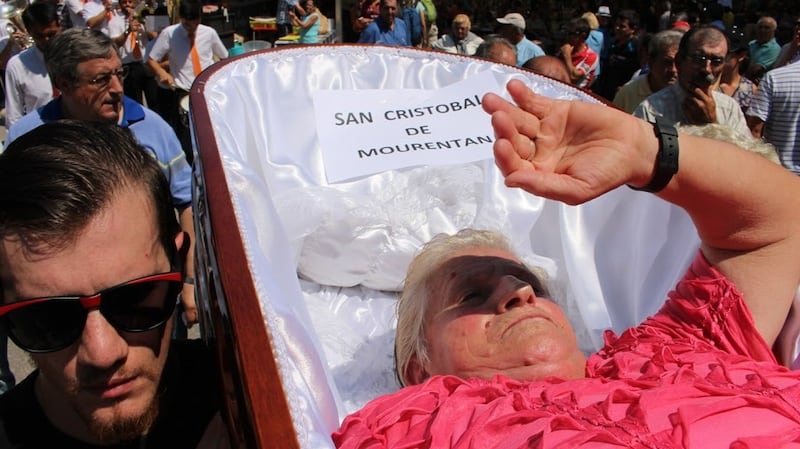Up in the bell tower a young man sounds the repique de campanas. The church bells ring. Loudly.
A bassoonist fans himself with his music sheet. A clarinettist purses her lips, waiting for the bombo drum players to roll out. Suddenly, the saint appears and the band and the cortege march away from the cemetery, playing La Marcha Funébre. The solemn procession begins. Along the funeral route we are offered tastings of wine. Tortillas and doughnuts are sold, along with children's plastic toys and plenty of raisin bread.
One corpse smiles and waves. Another fans herself. They regularly re-hydrate. This is not your average funeral.

In the tiny Spanish village of Las Nieves in Galicia, close to the Portuguese border, a strange ritual takes place on July 29th each year. As part of the Fiesta de Santa Marta de Ribarteme (named after the patron saint of resurrection, Santa Marta de Ribarteme, the sister of Lazarus), people who have had near-death experiences in the past year are placed in open coffins and paraded through the village following a statue of Santa Marta.
Three thousand people crowd into the village for this year's event. On both sides of the road, men raise glasses of Galician beer or pomace brandy to the saint. Ladies in widow weeds roll their rosary beads. A man stops boiling an octopus to bow his head to the sister of Lazarus. Many of the corpses are wearing sunglasses. One holds up a bottle of water, with a loud "Salud!", acknowledging all the toasts and replying to the mourners' wishes of good health.
It is 33 degrees in the Spanish shade, but much hotter inside a Spanish coffin.
Privately, quietly and reverently, some intone the hymn of the day: "Virgin Santa Marta, star of the north, we bring you those who have seen death and survived and stared into her eyes and been spared."
In Spain, a romeria is a pilgrimage, meaning "travelling towards Rome". This annual romeria in north-west Spain is a unique "near-death" pilgrimage.
Galicia, which claims to be one of the seven Celtic countries, is a place of lighthouses, capes, high cliffs, wind and turbot farms, oak and eucalyptus forests; there are Celtic hillforts, megalithic dolmens and petroglyphs, as well as huge sand dunes and slate Roman walls.
But it is primarily a place of death.
The Costa da Morte (Coast of Death) extends from Malpica in the north to Finisterre – which the Romans believed was the end of the world – and on to the village of Muros, an hour west of Santiago de Compostela. The notorious coastline, with its winds and submerged rocks, is full of memorials to those lost at sea. High crosses dot the landscape. There have been more than 800 shipwrecks along this coast, and thousands of lives lost. At Cabo Vilan, there is the English cemetery where 172 sailors from HMS Serpent were drowned in 1890.
Galicia is also a place of remembrance and thanksgiving.
Those who are paraded in open coffins recognise their good fortune and victory. Generosa, an elderly woman now, almost died as a child and made a promise to her mother 60 years ago that she would attend the festival every year. She has kept her word and has not missed one.
She wears a bobbin lace shroud and carries a long cross with a candle that is exactly her height. Later she will leave it in the church, renewing her faith and symbolising she is still placing herself into the safe-keeping of her favourite saint.
“It is a very important day for my family and other families,” she says. “I remember my mother and my pledge to her and the doctor who saved my life. But it is a happy occasion. We give thanks for surviving death and also to remember the dead. They are with us all the time.”
Around her, stalls sell votive offerings of yellow wax body parts – feet, heads and hands. Emblems of lives saved, diseased organs cured, and organs hopefully soon to be healed at Santa Marta’s intercession.
“We are here to touch and be touched by her. To communicate with her. To be saved by her,” one man says. He genuflects, makes his petitions, pays his homage and touches her effigy before putting money in the collection plate. Meanwhile, the pallbearers wilt under the fierce sun.
It is thought that the Near Death festival began in the 12th century. Some believe it was an attempt by the Catholic Church to adapt to deeply-ingrained pagan rites.
There are always empty coffins standing in the church; those who take part in procession donate them to the local community. They are for people who can’t afford to be buried. So they can “die well”.
Candles flicker everywhere. "They are balizas [beacons]", I am told.
“It is a very serene, reflective atmosphere. It is not macabre. It is an expression of joie de vivre. We all gain spiritual strength from this day. Not just those who have escaped the dark mansion.”
The brass band breaks out into El Evangelista, segueing into a paso doble. The bells peal again and, outside, "churrasco" spare ribs sizzle on the barbecues.
Santa Marta continues on her journey, past a bouncy castle. The pallbearers perspire as they shoulder their coffin-dwelling friends and family members back to the church. Cheese, chorizo, baby squid, razor clams and empanadas are raised in celebration, and more octopuses lose their lives in copper pots full of paprika.
At the end of it all, one corpse steps out of her casket and hugs her son. Another – the only man in the parade – heads straight to the beer tent. It was his round. The pallbearers celebrate with aguadeinte firewater before tucking into some well-earned traditional "fair-style" octopus.
GET THERE Ryanair flies from Dublin to Vigo via Stansted. STAY Parador de Turismo de Pontevedra, (parador.es) INFORMATION Spanish tourist office (spain.info); Turismo de Galicia (turismo.gal)


















